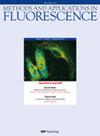一种高选择性、高灵敏度的比率荧光探针用于不同天然基质中Al(III)的定量检测
IF 2.4
3区 化学
Q3 CHEMISTRY, ANALYTICAL
引用次数: 4
摘要
报道了在水溶液中使用比率荧光增强对Al(III)进行高选择性和灵敏的测定。探针(命名为RS5)在与Al(III)离子结合时表现出54nm的红移。RS5在481nm处的显著增强反应归因于探针和Al(III)之间形成1:1的络合物,其中RS5充当三齿NNN供体配体。通过1H、13C和27Al NMR和HR-MS光谱技术确定了络合过程。该配合物的结合常数为1.3×105M−1。与Al(III)络合后荧光的比率变化归因于分子内电荷转移(ICT)跃迁以及螯合增强荧光(CHEF)过程的增加。该探针可用于监测pH范围为6-8的Al(III)。RS5检测Al(III)的检出限为0.3μM。为了了解RS5的传感行为,使用密度泛函理论(DFT)和时间相关密度泛函理论方法(TD-DFT)研究了探针及其Al(III)配合物的光学性质。该探针成功地用于测定天然基质如深井水、自来水、饮用水、池塘水、河水、牛血清白蛋白(BSA)溶液和血清中的Al(III),具有很高的回收率。本文章由计算机程序翻译,如有差异,请以英文原文为准。
A highly selective and sensitive ratiometric fluorescent probe for quantitative detection of Al(III) in different natural matrices
A highly selective and sensitive assay of Al(III) using ratiometric fluorescence enhancement is reported in an aqueous solution. The probe (named RS5) exhibits a red-shift of 54 nm upon binding with Al(III) ion. The significant enhancement response of RS5 at 481 nm is attributed to the formation of a 1:1 complex between the probe and Al(III), wherein RS5 acts as a tridentate NNN-donor ligand. The complexation process is ascertained by 1H, 13C, and 27Al NMR and HR-MS spectral techniques. The binding constant of the complex is determined to be 1.3 × 105 M−1. The ratiometric change in fluorescence upon complexation with Al(III) is ascribed to an increase in intramolecular charge transfer (ICT) transition along with chelation enhanced fluorescence (CHEF) processes. The probe can be applied for monitoring Al(III) in a pH range of 6–8. The limit of detection (LOD) of RS5 for the examination of Al(III) is found to be 0.3 μM. With an aim to understand the sensing behavior of RS5, the optical properties of the probe and its Al(III) complex are investigated using density functional theory (DFT) and time-dependent density functional theory (TD-DFT) methods. The probe is successfully employed for the determination of Al(III), with very high recovery percentages, in natural matrices like deep well water, tap water, drinking water, pond water, river water, bovine serum albumin (BSA) solution and blood serum.
求助全文
通过发布文献求助,成功后即可免费获取论文全文。
去求助
来源期刊

Methods and Applications in Fluorescence
CHEMISTRY, ANALYTICALCHEMISTRY, PHYSICAL&n-CHEMISTRY, PHYSICAL
CiteScore
6.20
自引率
3.10%
发文量
60
期刊介绍:
Methods and Applications in Fluorescence focuses on new developments in fluorescence spectroscopy, imaging, microscopy, fluorescent probes, labels and (nano)materials. It will feature both methods and advanced (bio)applications and accepts original research articles, reviews and technical notes.
 求助内容:
求助内容: 应助结果提醒方式:
应助结果提醒方式:


